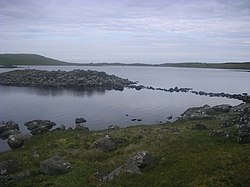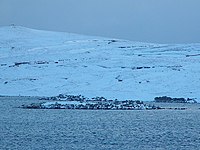Huxter Fort
| Huxter Fort | |
|
Shetland | |
|---|---|
 Connected to the shore by a stone built causeway | |
| Type: | broch |
| Location | |
| Grid reference: | HU55866200 |
| Location: | 60°20’18"N, -0°59’24"W |
| History | |
| Built Iron Age | |
| Information | |
| Condition: | Ruined |
Huxter Fort is an Iron Age fortification on the island of Whalsay, in Shetland, dating to around 300 BC. It is on an islet in the Loch of Huxter, connected to the shore by a causeway.
Origins
The fort was probably built around 300 BC, the generally accepted date of most similar fortifications in the region. It resembles other fortifications such as the Crosskirk Broch, the blockhouse in front of the Broch of Clickimin and the Ness of Burgi fort at Scatness.[1] It may be assumed that these forts were built by culturally-related people.[2] There are also similarities with stone forts in western Ireland, such as the Dunbeg Fort in County Kerry.[3]
In 1950, B.H. St.John O'Neil presented the view that the brochs were built to defend against Roman slave traders.[4]
This ring fort and blockhouse existed before the other two forts in Whalsay, brochs that were built just before the 1st century AD started.[5]
Huxter was standing until the 19th century.[6] When described in 1879, the fort was much less dilapidated than today.[7]
Structure

Entry to the fort enclosure was across the causeway, then through a passageway with rooms on either side and with a doorway in the center.[7] The entrance section is part of the main wall.[8] This is similar to the blockhouse at Clickhimin.
The passage is just 2 feet 6" wide at its opening, and 3 feet 6" at its inner end.[9] It has been conjectured that there may have been a two-story timber building built against the inner face of the fort. There is little structural evidence for this today.[10] However, early accounts of the fort indicate that this may have been the case, and other forts show traces of what may have been internal stairways.[11]
A ring wall runs around the islet, with a two-room blockhouse forming the defence opposite the causeway.[2] The ring wall seems to have been built separately from the main structure.[10] The blockhouse forms part of the ringwork, but is not bonded into the ring wall.[12] The weaknesses in the defence of this and related structures could be explained by additional defences of wood and thorn branches that have disappeared without leaving any trace. Another possibility is that the defences were mainly symbolic, and perhaps played a part in warfare that was conducted according to formal rituals.[12]
References
- ↑ Fairhurst & Breeze 1984, p. 166.
- ↑ 2.0 2.1 Harding 2004, p. 148.
- ↑ Henderson 2007, p. 186.
- ↑ Hamilton 1956, p. 114.
- ↑ Whalsay A thriving fishing community.
- ↑ The Shetland Blockhouse 1995, p. 475.
- ↑ 7.0 7.1 Turner 1998, p. 66.
- ↑ Prehistoric Society 1965, p. 102.
- ↑ Ministry of Public Building and Works 1968, p. 58.
- ↑ 10.0 10.1 Fairhurst & Breeze 1984, p. 38.
- ↑ Harding 2004, p. 147.
- ↑ 12.0 12.1 Harding 2004, p. 150.
- Fairhurst, Horace; Breeze, David John (1984). Excavations at CrossKirk Broch, Caithness. Society Antiquaries Scotland. ISBN 978-0-903903-03-5. https://books.google.com/books?id=yB49sTIoNrMC&pg=PA38. Retrieved 4 February 2013.
- Hamilton, J. R. C. (April 1956). "Viking Congress, Lerwick, July 1950 (review)". The Antiquaries Journal (Cambridge University Press) 36 (1-2). doi:10.1017/s000358150006073x. http://journals.cambridge.org/action/displayAbstract;jsessionid=A9EE4205AC2C3B94D485563514698FF5.journals?fromPage=online&aid=7860911. Retrieved 4 February 2013.
- Harding, Dennis William (2004). The Iron Age in Northern Britain: Celts and Romans, Natives and Invaders. Routledge. ISBN 978-0-415-30149-7. https://books.google.com/books?id=KTtJ9SbgNr4C&pg=PA148. Retrieved 4 February 2013.
- Henderson, Jon C. (2007). The Atlantic Iron Age: Settlement and Identity in the First Millennium BC. Psychology Press. ISBN 978-0-415-43642-7. https://books.google.com/books?id=vaBk13fMIREC&pg=PA186. Retrieved 4 February 2013.
- Ministry of Public Building and Works (1968). Archaeological Reports. H.M. Stationery Office. https://books.google.com/books?id=kUZnAAAAMAAJ. Retrieved 4 February 2013.
- Prehistoric Society (1965). Proceedings of the Prehistoric Society. The Society. p. 102. https://books.google.com/books?id=4oxRAQAAIAAJ. Retrieved 6 February 2013.
- "The Shetland Blockhouse". Proceedings of the Society of Antiquaries of Scotland. Society. 1995. https://books.google.com/books?id=JZdnAAAAMAAJ. Retrieved 4 February 2013.
- Turner, Val (April 1998). Ancient Shetland. B.T. Batsford. p. 66. ISBN 978-0-7134-8001-6. https://books.google.com/books?id=5ZwrAQAAIAAJ. Retrieved 4 February 2013.
- "Whalsay A thriving fishing community" (pdf). Heritage.co. http://www.shetland-heritage.co.uk/downloads/resources/geographicleaflets/Whalsay.pdf. Retrieved 4 February 2013.
| Prehistoric Shetland | |||
|---|---|---|---|
| Neolithic |
Benie Hoose • Funzie Girt • Hjaltadans Stone Circle • Pettigarths Field Cairns • Scord of Brouster • Standing Stones of Yoxie • Stanydale Temple • Vementry | ||
| Iron Age brochs |
Clickimin • Culswick • Mousa • Burra Ness • Clumlie • Huxter • Ness of Burgi • Snabrough • West Burrafirth | ||
| Pictish | Mixed period | ||